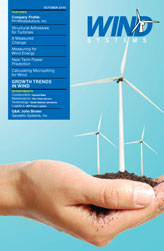Modern wind energy farms must achieve a long operational service life while keeping maintenance costs to a minimum. In order to achieve this, more manufacturers are investing in forward-looking product development. It is therefore of the utmost importance that the design engineer integrates the calculation of the individual mechanical components and the reciprocal effect with the environment in the development process as early as possible. This is where reliable calculation tools, together with professional knowledge, can make a critical contribution.
The new KISSsoft release 04/2010 includes methods for the design of machine components with important improvements relevant to the wind farms, such as tooth contact analysis and calculation of roller bearing service life—taking the internal geometry into consideration—and finally, the safety factor against micropitting.
Micropitting in Wind Energy
During the eighties, as the first large wind farms were appearing in the United States, the first shortcomings showed up as classic gearing or roller bearing damages such as pitting, tooth root fracture, scuffing, or bearing failure. Due to the high rotor speeds, micropitting was not considered to be as significant at the time. Figure 1
At the beginning of the 21st Century the power capacity of the equipment was drastically increased, and the rotor speeds were reduced. The classic tooth damage was more or less weeded out by collected experience and the above-mentioned policies. The bearing damages, however, were not. During the following years the equipment capacity went on increasing while rotor speeds were continuously reduced.
Presently, bearings still constitute one of the main reasons for operational failure in the wind energy sector, while micropitting damage became the center of attention for gear and equipment manufacturers. Or, to be more precise, it concerned the operators. With continuously rising equipment capacities, as well as reduced rotor speed in the wind energy sector, the micropitting phenomenon attained increasing importance. Hence micropitting must basically be considered for gearing design and modification, and for the choice of lubricant.
The Micropitting Phenomenon
When the lubrication film thickness becomes so thin that the flanks make metal contact—meaning that the surface roughness exceeds the lubrication film thickness—boundary friction prevails, leading to surface damage. Subsequently, gray spots will show up, lending the teeth flanks a matte appearance. This is the so-called micropitting.
The specific lubrication gap thickness λGF – the ratio between the lubrication gap thickness and the surface roughness is relevant for the evaluation of whether a tooth is endangered by micropitting, which is characterized by a surface damage in the form of fissures that grow from the surface towards the interior. It thereby causes small pittings of approximately 10-20 μm depth, 25-100 μm length, and a width of 10-20 μm. The phenomenon mainly appears on case-hardened gears, but it can also occur with nitrided, induction-hardened, or through-hardened gears.
The material removed from the flanks will inevitably cause an increase in tooth profile errors that will lead to a reduction in the overall quality of the teeth. After a certain time either a stagnation of this material removal occurs or the process continuously persists. Consequential problems—which may or may not occur—are increased dynamic loads that again can lead to an increased noise level and higher tooth load, resulting in pitting. If not promptly removed by effective lubricant filtration, the eroded material transported by the oil can cause bearing damage as foreign particles. Such filtering procedures are already standard in the wind energy sector.
Applicable Calculation Methods
AGMA 925, from 2003, defines a method to analyze the risk of micropitting, among other methods that cover scuffing and wear. The main outline of the method is to determine the temperature of the gear body, adjust the viscosity of the lubricant to this temperature, and then calculate the oil film thickness. The central formula for the film thickness is:

In this formula the index (i) denotes a specific point on the path of contact, so the method investigates each contact point individually. The factor G is a material parameter, taking the reduced Youngs modulus into account and the pressure viscosity of the lubricant. U(i) is a local speed factor. It is influenced by the dynamic viscosity at gear tooth temperature, the reduced modulus of elasticity, the local entraining velocity, and the local radii of the flank curvatures. Finally W(i) is the load factor. The main influence parameter here are the load sharing factor XΓ(i) – multiplied with the unit load wn – and the local curvature.
Some investigations were undertaken in Germany to calculate the risk of micropitting. The first method was proposed by the FVA in the early nineties. This method already invented the idea of a critical film thickness λ. However, it only took the situation at the operating pitch point into account. In a second paper, this one from 1999, the FVA introduced the formula

with basically the same factors that the AGMA uses, according to Dowson. Obviously, the main difference to the AGMA 925 is the local sliding factor S, which takes the flash temperature into account.
ISO Technical Report
ISO is currently working on a technical report, ISO/CD TR 15144, for the calculation of the specific lubrication film thickness λGF,Y. It was originally planned to extend the standard ISO 6336 by a part 7, covering this topic. During open discussions, however, this was changed to the creation of a technical report.
In the current state ISO/CD TR 15144 follows the philosophy of the FVA using the same basic formula, thus including the gliding factor S. This leads to significant differences in the calculated film thickness according to AGMA and the ISO TR. In KISSsoft both methods—AGMA 925, and the later one proposed by FVA—are implemented so that comparison is easy.
As demonstrated in Figure 2, especially in the section of the recess sliding, the film thickness according to ISO is having a different tendency than the one according to AGMA. Where the film thickness according to ISO stays quite constant, the AGMA method calculates an increasing film thickness. Figure 3 shows the flash temperature determined with the two methods. Here the differences are negligible.
In the draft of the calculation of the lubrication film thickness and the risk analysis regarding micropitting, the data for the determination of the permissible specific lubricating film thickness λGFP was missing. Values for λGFP had to be derived from the literature, whereby in this connection the data were often contradictory.
In the meantime, in the latest draft ISO/CD TR 15144 the determination of the permissible specific lubricating film thickness λGFP is included. With the implementation of this extension, the safety factor against micropitting can now be calculated. For the evaluation of the risk of micropitting, as already explained, it is critical how large the smallest specific lubrication film thickness λGFmin must be at minimum. Therefore it holds that λGFmin≥ λGFP must be fulfilled in order to avoid micropitting, or respectively Sλ=λGFP/λGFmin defines the safety factor against micropitting. Figure 4
The minimum lubrication film thickness in the meshing of a gear pair serves for determining the risk of micropitting damage. Theoretically, if the film thickness is large enough, no micropitting will occur. Only if the ratio of permissible specific film thickness and minimum specific film thickness drops below 1 is the risk of micropitting a given. It is then dependent on the choice of the lubricant—and especially the additives, and other boundary conditions such as hardening procedure and surface structure—whether or not micropitting occurs. In practical applications, of course, the additional problem of determining the appropriate data for the calculation comes up, so that a minimum safety larger than 1 might be appropriate. Practical experience should always complement the calculation procedure.
Level of Detail
For the implementation of the methods mentioned there are two different approaches. The first one implements the method including the calculation of the normal force, Hertzian pressure, and temperature according to the specifications in the standard. The second approach uses a simulation model for the contact of the gears to determine the respective values. This corresponds to the method A of the ISO. Of course, the effort for the second approach is much higher. On the other hand, with modern computers the calculation time of this more-sophisticated approach is no problem.
To compare the results of the two approaches an example of a spur gear pair with a tip relief as profile modification is used. The calculation is according to AGMA, which defines a load sharing factor XÐ(i) to take the tip relief into account (Figure 5).
The standard specifies that the tip relief shall be “adequate.” This leaves some room for interpretation. The left diagram in Figure 6A shows the resulting lubrication film thickness using the load sharing factor. In the right part of the Figure 6B the calculation was carried out with simulating the meshing of the gears, and thus determining the real normal force for a couple of different values for the tip reliefs (ranging from 15µm to 70µm). The resulting film thickness fits well to the first calculation if the tip relief has a value of 30µm. For the other values the curves are deviating, and most importantly for 15mm and 70mm the minimum of the lubrication film thickness is smaller than the minimum determined with the load sharing factor. Of course, 15µm are a too small a value and 70µm is a too large a value. Still, this comparison shows that the additional effort for the simulation pays back immediately, if only for determining the “adequate” value for the tip relief.
Summary and Outlook
KISSsoft permits the reliable calculation of complex interrelations and provides founded decision bases long before the construction of a wind energy installation actually occurs. A balanced and optimally sized design thereby leads not only to savings of cost and weight, but also to reliable forecasts on future behavior, stability, and service life of the installation. Operation and maintenance are easily and accurately calculated, and due to calculation software such as KISSsoft the probability of damage can be drastically reduced in advance. With the planned ISO/CD TR 15144 calculation method, the safety factor against micropitting may be dealt with in a quick and realistic way.








































